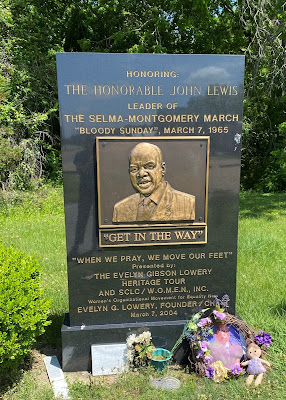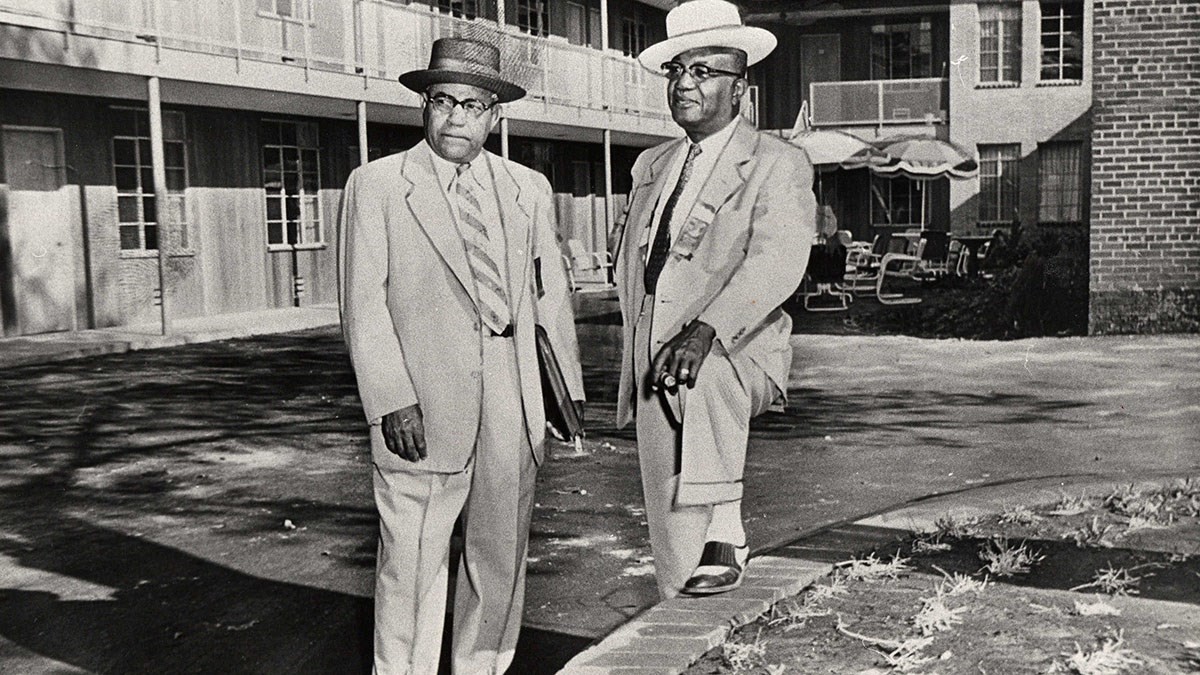 |
Isaiah Thornton Montgomery, Founder and Mayor |
The following is a complete excerpt from 1975 Application for Historic status for I.T. Montgomery House in Mound Bayou. It tells part of the story of the town's founding. The house attained listing on the National Register as a National Historic Landmark in 1976.
Located in the Mississippi Delta region of Bolivar County, the town of Mound Bayou was one of a
number of black settlements which was established during the post-Reconstruction period. It represents
one of many important attempts by blacks of that era to establish independent communities in which
they could exercise self-government.
The present town of Mound Bayou had its inception in a former settlement. Isaiah Thornton
Montgomery and his cousin Benjamin Green were the slaves of the family of the Confederate President
Jefferson Davis. As an alternative to the institution of slavery, it was Jefferson Davis' idea that
blacks be isolated on their own settlements. At the conclusion of the Civil War, in 1865, an actual
settlement was established on the former Jefferson plantation of Brierfield at Davis' Bend, twenty
miles south of Vicksburg on the Mississippi River.
The settlement survived for eighteen years. However, because of the problem of recurring floods of the Mississippi, the relatives and friends of
Montgomery and Green, all of whom were former slaves of the Davis plantation, abandoned the
small settlement and moved to Vicksburg where they awaited another opportunity to establish their
own community.
The Louisville, New Orleans and Texas Railroad was granted a large tract of land in the state.
This grant was made to encourage the development of agriculture, trade and commerce in the
fertile delta along the Mississippi River from Memphis to Vicksburg. As a result, fruition was
given to the establishment of Mound Bayou. It was the belief of railroad company officials that
only members of the black race had the ability to adapt to life in a semi-tropical climate which
was conducive to maleria (sic).
The assistance of Isaiah Montgomery was sought in soliciting black
workers. He, realizing the possibilities that it offered for another attempt at black self-government,
began an immediate investigation of its feasability (sic). He finally decided upon the site of the present
town of Mound Bayou, named for a large Indian Mound, located at the site of the convergence of two
bayous which drained the region.
Many of the settlers of the former colony came to Mound Bayou in July 1887, and began to
carve a town out of the wilderness and swampland. It was the inspiration of Montgomery that caused
other blacks from Louisiana, Alabama, and Georgia to join the effort. These settlers had one
common motivation: they wished to live free from the annoying and unnecessary restraints imposed
by continued residence to basic concepts of universal equality.
The prosperity Mound Bayou experienced, almost from its inception, was attributed to its
location along the railroad. Communication was facilitated by trade with other regions of the
country by the railroad. Its location in the fertile Mississippi Delta region allowed Mound Bayou
to produce cotton on a scale greater than that of any other region in the state.
Under the leadership of Montgomery, Mound Bayou by the turn of the century had developed
into one of the most prosperous and thriving communities in the state.
In 1904, the Bank of Mound
Bayou was founded by John Francis and Charles Banks. Its rapid growth necessitated the amendment of
its original charter to increase its capital from $10,000 to $25,000. By 1907, the largest enterprise
of its kind in the state, the Mound Bayou Oil Mill and Manufacturing Company was erected at an
investment cost of $100,000.
Finally, in 1912, Mound Bayou's petition to Mississippi Governor Earl Brewer for a town
charter and status as a town was immediately accepted.
The charter established an aldermanic
form of government with a mayor, town marshall, and five aldermen as the elected officials.
Throughout most of the town's history, these positions have been held by black men and women.
In the realm of education, teaching and learning played a significant role from the town's
beginning.
In 1892, the two co-founders, Isaiah Montgomery and Benjamin Green, recognizing
the importance of schools, donated a tract of land for educational purposes. Montgomery's sister,
Mary, a former student of Oberlin College, was the town's first teacher giving instruction in her
home. The American Missionary Association joined with Montgomery and Green in their efforts
and for twenty years the organization assisted them by sending money, supplies and teachers to
what soon became known as the Mound Bayou Normal and Industrial Institute. Professor B. F.
Ousley was the first principal, serving in that capacity for more than sixteen years.
Finally, in 1920, the school was enlarged into the Mound Bayou Consolidated Public School.
It was the only school for black children in the county. Moving into a three-story, fireproof brick building with sixteen well-equipped classrooms, an auditorium, the school had an enrollment of 850 students. The school's first two principals, Professor J. M. Mosley and Professor
John H. Powell, were graduates of Alcorn College in Lorman, Mississippi. In addition to the
conventional diploma-granting curriculum, the high school soon offered vocational training in
the industrial arts, agriculture, stenography, typing and bookkeeping.
By the turn of the century, Mound Bayou had begun massive improvements in its physical
appearance. Numerous shops, stores, fraternal buildings, institutional buildings and private
residences were constructed. It was likewise during this period, 1910, that the Isaiah T. Montgomery
house was constructed. This house stands typical of the progress and the development of the town.
It was through the direct efforts of I.T. Montgomery, who was founder and first mayor of
the town, which inspired and helped lead the town to its productive years. Montgomery possessed
a diversified background with experience in accounting, real estate and civil engineering--not
to include his effectiveness as a politician. Montgomery was most active in the Republican Party,
and he represented Bolivar County in the Mississippi Constitutional Convention of 1890.
Having
vested interests in real estate, Montgomery grew in this black community, to be one of the
wealthiest men in this county, black or white. Isaiah T. Montgomery died in 1924 leaving a legacy
of industrious leadership. Through his successful accomplishments during the post-Reconstruction
era, he negated the accepted postulate that blacks were incapable of independent community
development and self-government.
The house is a 1910 red brick structure of two stories over a full above-grade basement,
irregular in plan, with hipped roof and gables over projections. The front has a spacious porch
with square Doric columns resting on brick piers extending to grade, and is reached by a wide
flight of masonry steps. The windows are single light double-hung wooden sash. The double
front doors have a transom, full width of the opening. The com ice is of simple treatment consisting
of frieze board and extended eaves board

















